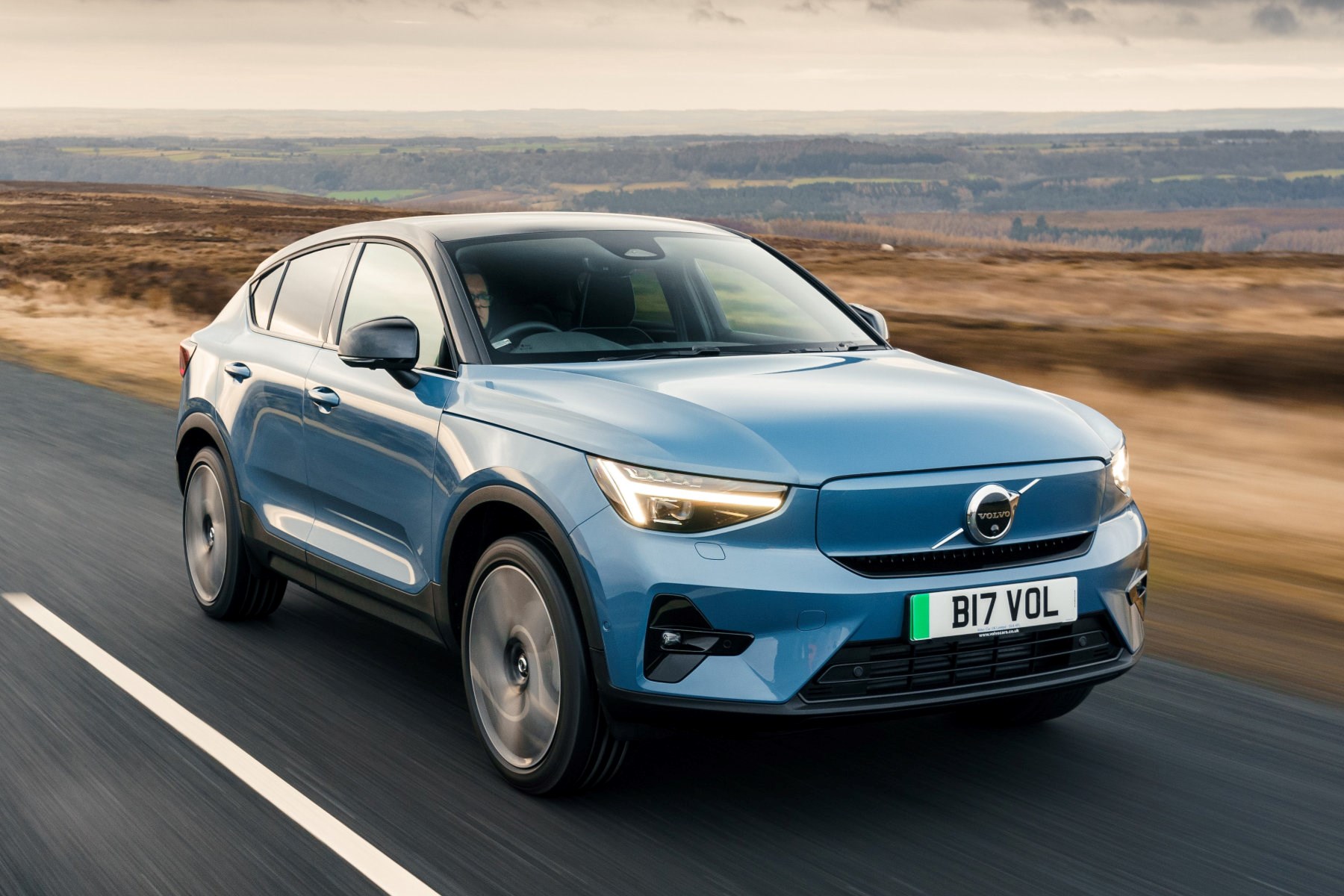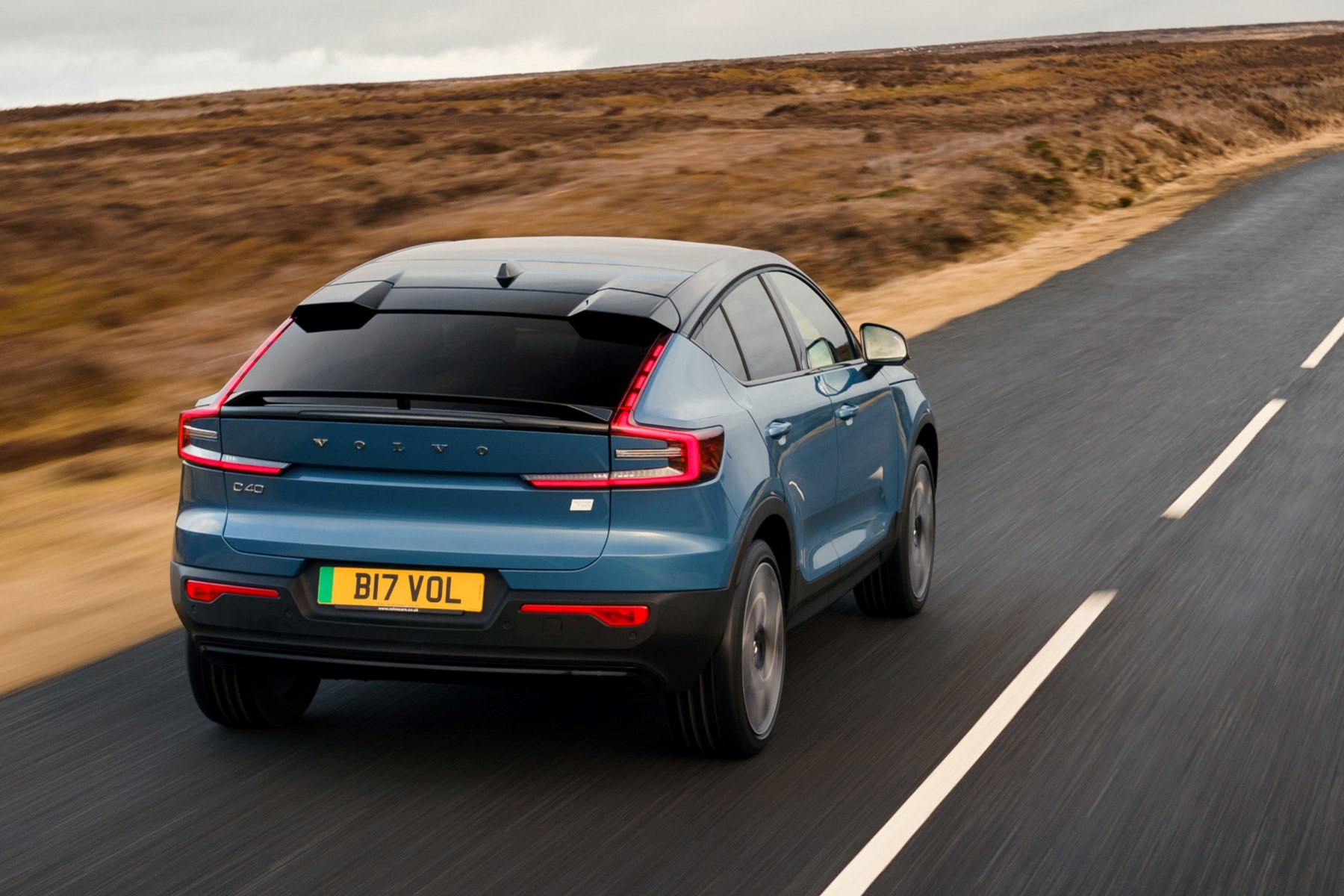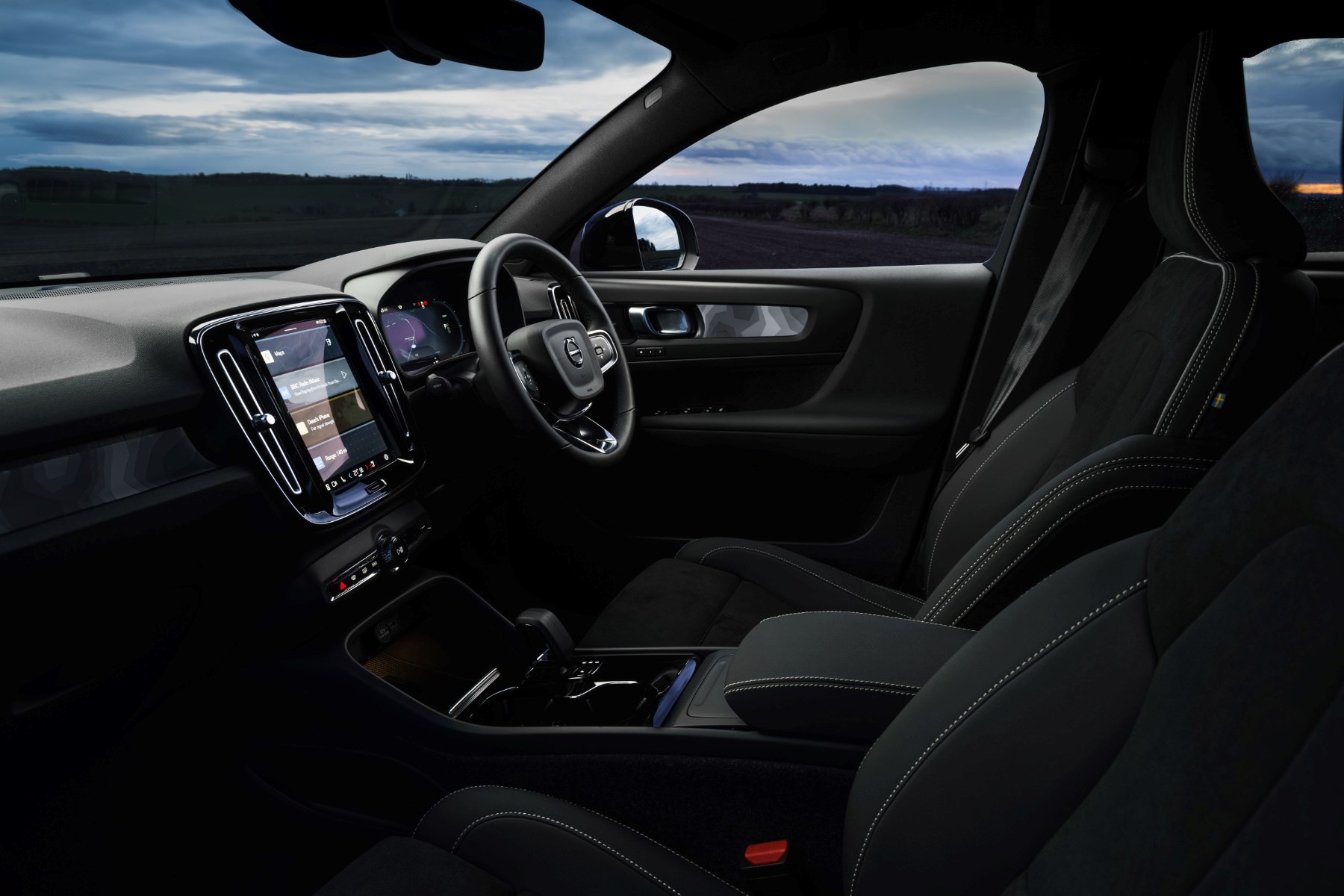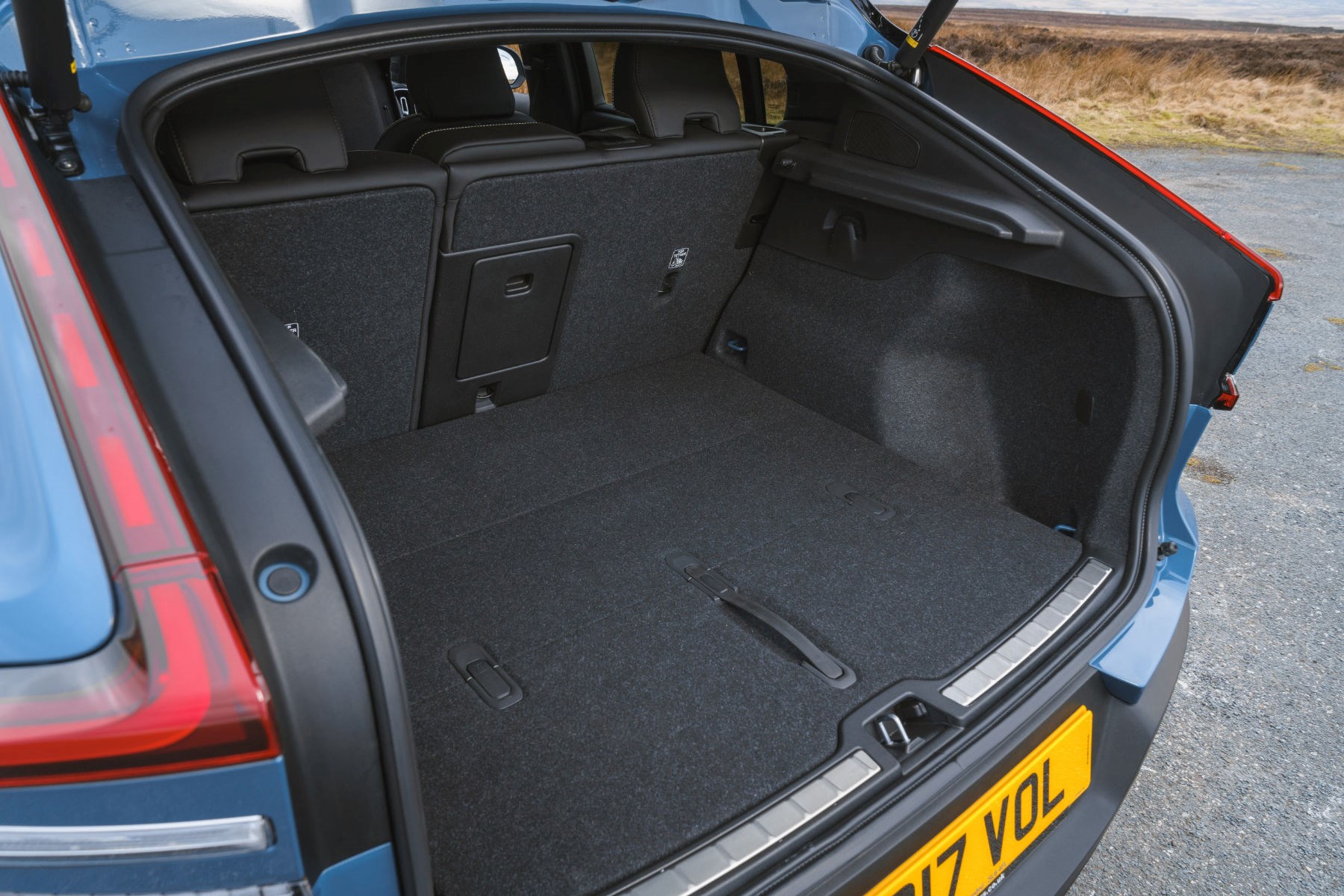► We test Volvo’s electric coupe-SUV
► All-wheel drive available
► But single-motor is now rear-drive
Although not the brand’s first coupe, the Volvo C40 is the first time the sensible Swedes have combined a fastback roofline with four-doors on an SUV base. To show that Bjorn and Lena in engineering aren’t totally po-faced, the top model chucks out 402bhp for a 0-62mph time of 4.7 seconds. More conservative customers can opt for a single motor version with a tamer 235bhp.
Unlike the XC40 with which it shares a platform, the C40 is exclusively all-electric. It features the new Android infotainment software that’ll eventually roll out to every other model in the range. And it’s only available online, either as a cash purchase or via the all-inclusive Care by Volvo subscription service. It is in many ways really something of a revolution for Volvo.
It’s also undergone one of the more interesting mid-life updates we’ve seen lately – with the previous front-motor, front-wheel drive layout being ditched for a rear motor and rear-wheel drive, all in the name of greater efficiency and a longer range. The twin-motor all-wheel drive model remains, though it’s been tweaked too.
But is it any better than an Audi Q4 e -Tron, a Mercedes-Benz EQA or a Tesla Model Y? Read our detailed Volvo C40 review to find out more.
So, what do you get for the money?
The C40 is offered in three trim levels with two powertrain choices. Core is, as you’d imagine, base spec. Mid spec is called Plus and top-tier is called Ultimate. Save for a towbar and charging cable, there are no options save for colours and wheels.

The twin motor cars get 402bhp and an official 342-mile range. This is competitive with rivals – the previous model only managed 278 miles on the WLTP cycle. Efficiency gains for the AWD cars come from a different motor layout – ditching the equally-matched 201bhp motors front and rear for a 254bhp Volvo-developed motor at the rear and a 148bhp motor at the front. The front motor is now asynchronous, too, so it can be disconnected when it’s not needed to boost efficiency.
The battery’s a little larger, too – 82kWh up from 78, and with improved cooling.
The front-wheel drive version has 235bhp and a 0-62mph time of 7.3 seconds. Range is an official 297 miles, leaving a bigger gulf between it and the twin motor than pre-facelift – but it’s still a 25-mile gain from the previous car. Its 69kWh battery also benefits from improved cooling, but charge rates are actually slower than before – a maximum of 130kW.
Official consumption is 3.7mi/kWh for the single motor but on our test drives we averaged around 3.4. That still means a very usable 230-ish miles of range during mixed mileage – not to be sniffed at, and we’ve always found Volvo’s range indicator accurate.
Group test: Tesla Model 3 vs Hyundai Ioniq vs Polestar 2 vs Audi Q4 e-Tron
What’s the Volvo C40 actually like to drive?
Your first impression is how high-riding the C40 is. You tower over most traffic, even other crossover drivers, much like the regular XC40 making it feel larger than it actually is. It means you get a good view out, but you sometimes feel on tiptoes. Secondly, the twin-motor C40 is seriously quick: it’ll will leave a Q4 e-Tron or Mercedes EQA for dust off the lights, though a Tesla Model 3 still has the Volvo licked.
Even so, we’d stick to the significantly slower single-motor. Lets face it, a 7.3 second 0-62mph time is plenty for something that’s likely to see family duties. If you were hoping the switch to rear-wheel drive would make this a sportier SUV, prepare to be disappointed. Though there’s less scrabbling off the line, and slightly improved clarity in the steering, you’d be hard-pressed to tell the difference between the two cars unless you drove them back to back.
Volvo’s simplified the driving experience. To begin with, there’s no starter button or even handbrake. Simply get into the car, shift to D and you can set off. It’s remarkably like the Polestar 2 in this regard – small wonder, since the two are both based on the Swedish/Chinese CMA architecture.
Once you’re going, you’ll find only three controls to tailor how the car drives, and instead of being on a dedicated switch they’re hidden in the settings menu on the touchscreen. There’s an off-road mode that’ll gather as much dust as a virtual button can, as well as a control to firm up the steering – probably to make it feel ‘sportier’ though all it really does is add to the sensation of weight.

The button for ‘One-Pedal Drive’, though, is one you might want to keep pressed. It ramps up the regen and can bring you to a complete halt with little to no need for the brakes. A few other EVs offer this, but Volvo’s judged it really well and it makes for very smooth progress once you’ve got the hang of it. You barely have to touch the middle pedal during much of your day-to-day driving.
Relatively remote steering and a little body lean add to the feeling this isn’t a car to be hustled, whether you’ve opted for the single or twin motor. Let the C40 lope along and you’ll find it comfortable, though – 20in wheels do thud a little round town but settle down to a nicely resolved ride on faster roads. Smaller 19s are better but not transformative.
Still a Volvo inside?
Fully vegan upholstery plus 3D-printed dash panels seem rather Gen-Z, but that’s not a bad thing when they’re featured in an interior that still holds up so well even though it was introduced on the XC40 back in 2017.
Those contoured black plastic dash panels are the main point of difference from the XC40. They feel a bit cheap to the touch, and look rubbish during the day, but at night they’re backlit and give a genuinely eye-catching effect with a three-dimensional, almost holographic quality.
Hugely comfortable seats are another highlight of the C40’s interior, while the dash is based around a nine-inch portrait infotainment touchscreen and a high-quality screen for the digital dials in front of the driver.

The Android infotainment setup isn’t brand new – it’s already on a couple of Volvo models as well as the Polestar 2 – and it works really well, with direct integration with Google’s services, Google Maps baked right in and support for apps downloaded from the Play Store. The mapping in particular is a gamechanger, while Google’s voice commands are far superior to any OEM system we’ve so far tested.
The more you’re already integrated into the Google ecosystem, the better it’ll be – you can even link up to smart home products. There is Apple CarPlay available to keep iPhone users happy, too.
There are some annoying details: the temperature control buttons on the screen are some of the smallest we’ve ever seen and easily misprodded when driving. It’s a rare ergonomic fail by the usually practically minded Swedes.
As for space, that coupe roofline doesn’t impact two rear passengers too much (we wouldn’t recommend a third occupant in the middle). Legroom’s decent and only the tallest passengers will moan too much about headroom, even with the full-length sunroof specced. Just watch out for peculiarly narrow back doors, which makes sliding in and out tricky.

The boot’s another matter – it’s pretty shallow, though nowhere near as bad as a Lexus UX 300e, and the button to open it is tucked annoyingly low down by the bumper. The batteries packed underneath mean it’s high up and dogs will have to clamber 75cm up to get in. The rear seats can be folded individually 60:40 and there’s a ski hatch for longer items to poke through into the cabin.
Like many electric cars, there is a small ‘frunk’ (front boot, or trunk) where you’d normally find a petrol engine. It’s not a huge space, but is perfect for stowing away the charging cables. Another practical touch is plastic clip by the driver’s side A-pillar; useful for holding parking tickets.
Verdict
The Volvo C40 Recharge is a stylish electric car with an excellent turn of pace, reasonable range and a quality interior. It just doesn’t feel particularly special for a car that’s meant to be Volvo’s electric flagship – and looks aside, there’s little really to recommend it over the XC40 Recharge.
Besides, a Tesla Model Y is cheaper and will go farther, while a BMW iX1 is a more entertaining steer.